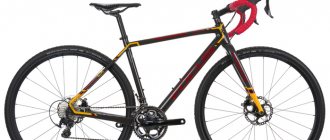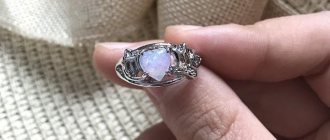Let's talk about how to ride a bicycle correctly, because knowing how to ride does not mean riding technically correctly. Meanwhile, your endurance, comfort, and safety depend on technology.
Talk about safety! If you are a beginner and just learning to ride, be sure to wear a protective helmet on your head and special pads on your elbows and knees. Learn to ride on a flat and smooth surface, without holes and bumps. Be sure to study the literature on the topic “how to fall off a bicycle correctly”, because, unfortunately, you cannot do without it at the initial stage.
So, let's find out how to ride a bike correctly - we'll study each step in detail from scratch. Ready?
Preparation (what to check before you ride)
Before moving on to the rules - how to properly ride a bicycle on the road, let's prepare for the first training session:
- Find a deserted area with a level surface. If you have trouble with balance, try it on a soft grassy lawn or a country road with crumbly soil. Keep in mind that on such soil it is “more pleasant” to fall, but riding and pedaling is much more difficult;
- It’s good if the area chosen for training has gentle slopes - this way you will learn how to drive downhill and back correctly;
- Check the rules for riding bicycles in your city - is a helmet required, is it possible to ride on sidewalks, etc.;
- Wear comfortable clothes that will not cling to the mechanisms and interfere with your ride;
- It is advisable to choose closed-toe shoes to protect your toes during falls or emergency braking;
- Learn to ride during the day, in good dry weather. Take with you water, a good mood, and, preferably, a companion who will help with balance at the beginning.
How to sit down
Well, you got ready, found a site, got dressed, and didn’t forget about the protective kit. It's time for practice - let's find out how to properly ride a bike on roads and highways!
- First, lower the seat so that you can place both feet on the ground while holding the bike between your legs.
- Try to push off the ground with your feet and ride forward a little - feel how the bike rolls, try holding the handlebars and turning a little;
- Now it's time to ride and pedal. Sit up straight, physically feel the weight of your body and try to distribute the weight evenly on both sides. Place one foot on the top pedal and press down gently in a circular motion. Immediately place your other foot on the bottom pedal and pick up the movement, pressing it when it is at the top;
- Look forward - if you study the ground, you will definitely fall and never make friends with your balance;
- If you have a helper, have him or her support your lower back. Not for the bike, because in this case it helps you maintain balance.
How to brake correctly
To properly pedal a bicycle, it is important to learn how to brake. In this case, you will subconsciously be confident in your safety, because you can stop at any time.
Bicycles are equipped with a foot or steering brake. Sometimes both.
- If there are levers on the steering wheel, these are steering brakes; they are responsible for the front and rear wheels. Understand the mechanisms of their operation, press the handles while slowly rolling the bike next to you. You will see that if you press the rear brake, the rear wheel stops spinning. If it’s the front wheel, the front wheel stands up, but before that the bike “jumps forward” slightly.
- The foot brake is activated if you pedal in the opposite direction - to do this, simply press the rear pedal towards the floor.
- Fixed-gear bikes don't have brakes, so to slow down, stop pedaling and hold the pedals horizontally with your whole body leaning slightly forward.
To properly dismount from a bike, you need to first place one foot on the surface, then cross the other so that the bike is on the side.
Which brakes are better to choose - disc or rim?
Since we are talking about brakes, it is worth answering such an important question: what type of brakes is better to choose? Powerful disc or inexpensive V-brakes, or, as they are also called, rim brakes?
First of all, who said disc brakes are more powerful than V-brake? Everything will primarily depend on the quality (price) of the brakes. Some high-quality rim brakes, for example from Shimano, can be more powerful than average disc brakes.
Secondly, for ordinary rides nothing better than V-breaks has been invented, because they are: cheaper; weigh less; more reliable; They brake well and have a number of other significant advantages.
Therefore, if you are a beginner, it is better to get a bike with rim brakes.
How to ride correctly
Correct cycling is based on maintaining balance and measured pedaling. In turn, correct pedaling on a bicycle is based on the concept of cadence - the frequency of a full revolution during rotation. So, if you know how to ride correctly, you have a stable cadence - this means that the rotation speed does not decrease due to slopes or climbs. The exception is if you want to slow down or accelerate.
If you manage to “catch” your cadence, you will be able to ride your bike for a long time without getting tired and having great fun. In this case, the most important thing is to turn the pedal not only at the stage of a comfortable quarter of rotation, but throughout the entire revolution. Try to drive this way - once you understand it, there will be no further problems.
To learn how to maintain balance, forget about it. Just get in and drive. Yes, you will probably fall a couple of times at first. Then you will skid from side to side, and the bike will stubbornly try to ride in a circle. It's okay - believe me, this happens to all beginners. A couple of workouts and you will learn. Moreover, you will never understand at what point the problem with balance disappeared. You just realize that this is no longer a problem for you.
Women's bicycle
This is how he was before.
This is due to the fact that women traveled in skirts or dresses. Naturally, it would not be decent to throw your leg high from behind the frame, and the star needed better protection so as not to twist the hem of the dress. Now such problems are a thing of the past. The fair sex wears shorts or pants, but cunning marketers are still trying to convince us that a bicycle for women should be structurally different. Allegedly, this is due to the different anatomy of men and women: shorter thigh, longer little toe, etc. The frame is made a little shorter, the top crossbar is lowered lower, just as it was done before, the springs on the fork are softer, and the bikes themselves are smaller. Chasing ghostly, subtle features, manufacturers forget about the main difference between people and bicycles: height. As in men's bicycles, the handlebars are not adjustable in height or are adjustable, but within small limits. As a result, it will be even easier to fly over the handlebars when going down a hill. It becomes more difficult for tall girls to choose a bike because manufacturers believe that all representatives of the fair sex are shorter than men.
How to turn correctly
To properly ride a bicycle on the road and track, you must be able to not only ride, but also turn.
- While driving, smoothly turn the steering wheel in the direction you want to turn;
- Feel how the bike behaves, feel the change in direction;
- Maintain your balance;
- At first, do not jerk the steering wheel too sharply or try to make a sharp turn;
- If you lose your balance, apply the brakes or jump off the bike with one foot to the ground (only if the speed is low).
As you can see, learning how to turn correctly on a bicycle is not difficult, the most important thing is to maintain balance and take your time.
How to ride correctly when going down a hill
Despite the fact that a bicycle can ride downhill on its own, descending also requires proper technique:
- The first couple of times, go down several times without pedals, with the seat lowered so that you can slow down with your feet (just in case);
- When you learn to maintain balance, try placing your feet on the pedals;
- When descending, try to apply the brakes gently to slow down slightly. Do not brake with a stake under any circumstances, otherwise you will fly head over heels;
- When the descent is complete, calmly continue moving forward.
Squeaky chain
A few more words about the chain. It is really neglected by many beginners.
Not only can a squeaky chain infuriate you and the friends you ride with, but it can also cause serious expense and injury.
Firstly, an unmaintained chain (dirty, without lubrication) not only wears out faster, but also “eats” the teeth on the sprockets. This means there is a serious problem: you will have to change the cassette – the rear sprockets – ahead of schedule.
Secondly, a dirty old chain can break under load. This usually happens on a climb, during intense pedaling, when peak loads are placed on the cranks and chain. The rider's flight can be very spectacular and most often extremely painful.
see also
The working principle of a bicycle transmission
At a minimum, clean the chain with a special cleaner several times every two weeks and lubricate it with a special lubricant. She will thank you!
How to change gears/accelerate correctly
So, we have learned how to pedal a bicycle correctly, then it will be a little more difficult. Let's learn the basics of proper gear shifting:
- It is most convenient to change gears with your left hand;
- For reverse gear use the right hand;
Here's how a bike's gearbox works: Low gears make pedaling easier, but you'll only cover a short distance. High gear is more difficult, but you will travel much further.
To downshift, move to a smaller sprocket in front or a larger sprocket in the rear. And vice versa.
So, to go faster and further (to accelerate), shift to higher gears. To overcome a difficult area with bumps and holes, that is, to slow down, turn on the lower ones. It is recommended to turn and brake in lower gears. If you want to be able to ride a bike uphill properly, also master lower gears.
It is recommended to learn to drive and operate the gearbox on level ground. You should feel that when you change gears, it becomes easier or harder for you to pedal and feel like the bike literally rushes forward and rides for a long time on one revolution, or makes a full rotation in much less time.
If you learn how to accelerate on your bike correctly, that is, to do it with minimal physical effort (and that’s what you need a gearbox for), riding will become a complete pleasure for you.
What to do if you see an obstacle in a turn?
A very important question, unfortunately, almost not of concern to many beginners. But for experienced riders, this situation worries or even scares. Suppose there is a closed high-speed turn, you fly into it at full speed and suddenly you see a tree lying on the trajectory! What to do? Maneuver? You can't brake!
A lot, or rather everything, will depend on the conditions of the current situation: speed, distance of the obstacle, surface and quality of grip, presence of a shoulder, and so on.
In some cases, it’s worth turning, in others, jumping over an obstacle (the technique is called “bunny hop,” but this is for very advanced riders), in others, braking... STOP! After all, you can’t slow down?!
In fact, you can't brake in a turn while at an angle (putting your bike into the turn); If you straighten the trajectory for a moment (that is, stand the bike straight), then at that moment you can use the brakes, but only very intelligently and carefully! The trajectory will straighten out, but the speed, if it is possible to carry out several such maneuvers with braking, will drop, which will make it possible to either make a sharper detour maneuver, or, at least, at a low speed it will be possible to pull off the side of the road or fly into the bushes in extreme cases. This is clearly better than falling!
see also
A practical guide to cycling in the city
But in reality, this scenario almost always results in the rider falling. Even for an experienced cyclist, holding a bike is very difficult!
Therefore, the advice here is this: don’t accelerate if you can’t see what’s in/around the corner(s).
How to park correctly
Next, we will find out how to properly park a bicycle in a parking lot - this is important to know from the point of view of ethics in relation to the people around you. And also, this is a guarantee of the safety of your iron horse and a guarantee that it will not be stolen.
- Park and fasten your bike in special parking lots;
- If there is no designated parking for a bicycle, find an iron fence, but place the bike on the inside of the fence so that it does not interfere with passers-by;
- Among other bikes, fasten the bike in the middle (it’s safer);
- For strapping, look for a fixed object that is difficult to break or uproot;
- Block the frame, and not just the wheel, which is easy to unscrew and leave with the main structure;
- Be careful not to place the lock too close to the surface. In this case, it can be easily broken using a bolt cutter that uses the ground as a fulcrum;
- Attach the lock so that the hole is directed towards the ground - this makes it more difficult to break into;
- You can park your bike with two locks or one and a chain;
Actions and Events
Losing a vehicle in a dream means missing out on the chance to achieve what you want. If you dreamed of selling a two-wheeled friend, in real life you are shifting the solution to some important problem onto someone else’s shoulders.
Why do you dream about buying a bicycle? This vision illustrates your strong readiness for changes in life. Theft of a vehicle in a dream, if you yourself are the thief, remains a positive sign: you will show dexterity and courage in solving the existing problem. If your two-wheeled friend was stolen from you, it means your plans will be thwarted. Sometimes such a vision simply reflects a person’s obsessive fears of suffering some kind of material loss.
Condition and appearance of transport
A broken bicycle in a dream can be seen on the eve of some illness or during periods of severe fatigue. In this way, a person’s unconscious tries to warn him about the need for rest. According to Loff's dream book, a bicycle without wheels is a symbol of the dreamer's waste of energy. Probably, an erroneous method of action has been chosen, which, despite all the person’s zeal, will not lead him to his cherished goal.
Why do you dream about a children's bicycle? If you suddenly see a vision of your old three-wheeled friend, you are probably going through great difficulties in life. And you want to go back to the past, when everything was simple and easy. According to Miller’s dream book, dreaming of riding a children’s bicycle means trying to solve problems in a rather primitive way. You clearly use childish behavior patterns when overcoming life's difficulties. Which is not only ineffective, but also just doesn't suit you.
Note! If you dream of a bicycle of a certain color, this also matters.
For example, a black vehicle is usually seen in dreams related to career issues and gaining greater influence in society. Seeing a white bicycle in a dream means positive changes in business. The pink color of the two-wheeled friend reflects the romantic and somewhat infantile mood of the dreamer in reality.
Why do you dream about a red bicycle? Such a bright and rich coloring of the vehicle shows that the dreamer is driven by very strong emotions and passionate desires. Depending on other aspects of the dream, we can talk about both sexual desire and difficult-to-control aggressive impulses.
How to jump on a curb
Of course, the height of the obstacle should be reasonable - no more than 25 cm, otherwise it is better to dismount or go around;
- Slow down at the curb;
- Lift the front wheel upwards by the handlebars;
- When it is in the air, as if plant it on the curb and immediately transfer your body weight forward;
- The rear wheel, having lost the load, will jump onto the obstacle itself, following the front one;
- That's all the technology.
- To pull off a curb, also slow down, shift your body weight back and lift the front wheel slightly up. Slide gently off the obstacle and continue moving.
Correct cycling technique seems difficult only at first. The whole point is that as soon as you master its basics, you will immediately be able to drive technically correctly without any problems. It's like swimming - once you learn to keep your body afloat, you will never drown. Good luck to you! And finally, some nice statistics. On average, a person only needs 8-10 lessons with a bicycle to learn to ride quite well.
Suspension fork
At first glance, this is an excellent thing, it allows you to hide road unevenness and easily drive up curbs. But there is one unpleasant thing. When descending a hill, when the front wheel hits even a small hole or bump, the bike sends you somersaulting over the handlebars, and the softer the springs, the more dangerous it is. Here, of course, there is also the fault of the low-set handlebars, which are moved forward, which causes the cyclist’s center of gravity to shift. To prevent this from happening or if the springs fail, professionals replace them in the fork with reinforced rubber hoses.











